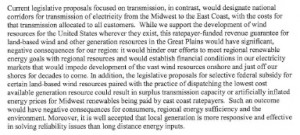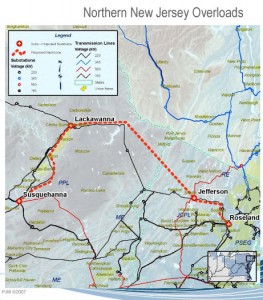Mid-Atlantic’s MAPP line cut short
May 20th, 2009
PJM, Delmarva Power, PEPCO, PHI, whatever, admit that demand is down and that the Mid-Atlantic Power Pathway, the transmission line through Maryland and Delaware to New Jersey, should be delayed
The Mid-Atlantic Power Pathway, or MAPP, is part of PJM’s “Project Mountaineer,” a web of lines expressly designed to move coal generation from the Amos plant in West Virginia and gather other coal and nuclear generation and send it in a northeasterly direction:
See the MAPP line there in the NE section of Project Mountaineer line 4?
PJM has recommended delay of the inservice date for a portion of the MAPP line by a year, the portion from Indian River to Salem nuclear plant. What remains, however, is a problem, because electrically, it makes no sense to build a 500kV radial line to nowhere. If part of the line should be delayed, the ENTIRE line should be delayed.
Here’s the corporate Press Release and two “articles” which should be compared!
Press Release from Delmarva site
MAPP: Controversial High Voltage Electric Transmission Line Delayed for One Year
PJM Reinforces MAPP Need: Adds Year to Schedule (states “contributed by Delmarva Power”)
This demonstration of lack of need is something that should be raised in the Delmarva Power IRP docket, that demand is down so significantly that PJM thinks infrastructure construction should be delayed. And yes, PJM demand is way, way down.
So, since demand is so far down, this is a good time to let the PSC know, in the Delmarva Power IRP docket, that we know that demand is down, so far down that they can’t cover anymore and they have to postpone some of their infrastructure construction. The Hearing Officer is taking public comments on the Delmarva Power IRP until some time in July, I think the 25th.
Send IRP Public Comments to the Hearing Eximaner Ruth Price:
What’s an IRP Comment? The Integrated Resource Planning process is supposed to be the way a utility plans ahead to cover their demand, and it’s essentially the intersection of energy policy and those #(%&*)#*( utilities. This is the arena where it’s determined whether they should meet their demand through conservation (the cheapest and environmentally the smallest footprint), efficiency steps like load shifting and SmartGrid, offshore wind paired with natural gas for backup, and whether external costs of various generation options are taken into account. SOOOOO, does that give you an idea of what’s up?
See Delmarva Power’s IRP docket at the PSC, scroll down beyond that rulemaking on the top:
And note this sly trick — they couldn’t get their IRP right from last cycle and were told by PSC staff to take it home and try again, and the last revision of that last IRP is the one they submitted:
And they said in their accompanying letter that this one should be for THIS cycle! AAAAAAARGH!
So, it’s time to review this joke of an IRP, take a look at PJM load forecasting, look at PJM and PEPCO SEC filings like their 2008 10-K and 2009 1st Quarter 10-Q:
Dig up some good conservation reports and sent them in as examples of what can be done. Let them know that with PJM demand down, we expect some changes, that this is a good opportunity to take a sustainable fork in the road, when demand is down we can make conscious choices.
Once more with feeling, check out the Delmarva Power IRP and send comments to ruth.price@state.de.us.
PSE&G Discovery – Susquehanna-Roseland line
May 17th, 2009
It’s been a busy couple of weeks, with Discovery to and fro with PSE&G. Here’s the results:
This is their response to the BPU Discovery. Although Ken Sheehan at BPU had said we could proceed with Discovery before we were parties, we’d sent the blanket request for others’ requests to avoid duplication and find out where we were at, but they ignored it, and even BPU would not forward their requests… so we sat in the dark until after our intervention was formally granted. I asked again, and lo and behold, that same day, BPU turned over their requests and PSE&G turned over their respones to BPU Discovery. Many of the responses aren’t, so I imagine there’ll be some wrangling about that.
Here’s what we’ve sent to them so far:
The Discovery deadline for the Direct Testimony has been extended to June 5th.
Are we having fun yet?
Eastern Governors stand up against Transmission!!!
May 6th, 2009
Yeaaaaaaaaaaaa! One for the home team!!!!
First it was NYISO and ISO-New England:
Then it was New York’s Deputy Secretary of Energy testifying before Senate Energy Committee:
And now the Governors from the Northeast and Mid-Atlantic states have stood up against the insane Midwest transmission plans — transmission plans like CapX 2020, JCSP/MTEP, Green Power Express, and the unnamed group announced on April 3rd, starting in North Dakota, banding southern Minnesota, and shooting out into Wisconsin.
Here’s their letter:
It’s blurry, so click the letter and read the whole thing. An eye opener for the Midwest, those who don’t recognize that there’s a big world out there and it’s not all about Midwest wind. Folks, you have a marketing problem, your target market says NO! What about NO can’t you understand?
The GALL of GRE’s Kaul!
April 30th, 2009
Will Kaul, VP of GRE, let loose in response to David Morris’ opinion piece a few days ago. What a doozy! How dare he! Talk about out of touch with reality! Maybe he’d better ask a few of the thousands who showed up and commented on this insane series of transmission projects across Minnesota known as CapX 2020.
You can call him and tell him what you think. Will Kaul @ GRE (763) 241-2380!
Will Kaul: Citizens have plenty of input on utilities
The facts on three new power lines came out in dozens of public events.By WILL KAUL
Last update: April 30, 2009 – 11:05 AM
The above quote, “to be a formal intervener, an individual or group simply had to sign up,” is false, and the utmost in arrogance. Kaul … read more sure wasn’t at the CapX proceeding that I was at, and it looks like he hasn’t read the transcript. If he had, he’d know that a couple weeks into the hearing, the judge issued an Order to Show Cause to two intervenors, the Prairie Island Indian Community and United Citizens Action Network to explain why they shouldn’t be booted out! Prairie Island Indian Community said they’d withdraw and maybe intervene in the siting docket. U-CAN, landowners in the route corridor, succinctly told the judge they had every right to be Intervenors, there were no requirements for level of participation, and btw, they were in the middle of condemnation proceedings for the MinnCan pipeline (another of her dockets and recommendations!) and didn’t have resources to do much in CapX. The judge then graciously allowed them to remain in the proceeding. nocapx2020.info/?p=324 Electric use is down, down, hence NoCapX 2020’s Motion to Reopen (November and last month), and soon, Motion for Reconsideration and then appeal. The forecasts are old, 2004-2005, and Xcel admits in its SEC filings that 2007 and 2008 saw declining beaks, SIGNIFICANTLY declining peaks, over 11% in just two years rather than their 2.49% increase, 1.5% increase, or whatever other number was dreamed up for the occasion. Those two years alone push any claimed need for this project way out there in time. And even if there was the “need” that they claim, the physical conductor is way over-spec’d, many many times what’s necessary for even the most generous forecast, and then they have the nerve to upsize it, doubling it, with zero justification! “The PUC upheld the recommendation of the judge…” Of course, they’re supporting MISO’s economic dispatch, rather than ratepayer interests, rather than the public interest. It’s time for a shake-up, not the usual shake-down. Yes, the many pages of transcripts, testimony, exhibits reflect the facts, but the ALJ recommendation and PUC decision do not reflect those facts or the purpose and reality of CapX 2020. From the utility squeals, it’s clear David Morris hit a nerve by being right on target.
An April 24 opinion piece by David Morris (“If it’s citizens vs. utilities, utilities win”) criticized the process state regulators use to review and approve new transmission lines and questioned whether Minnesotans had an opportunity to participate in the recent proceedings concerning three 345-kilovolt lines proposed by CapX2020, a group of 11 utilities.
The piece also made a rather bizarre comparison between sports stadiums and electric transmission lines. Electricity is an essential service that every Minnesotan depends on 24 hours a day, seven days a week.
The state regulatory process encourages public participation. It requires an independent review to ensure that utilities’ plans undergo a thorough and comprehensive vetting.
In the CapX2020 case:
•The Minnesota Department of Commerce held 10 public meetings, and an administrative law judge held 19 public hearings. Any interested citizen could attend and speak.
•To be a formal intervener, an individual or group simply had to sign up.
•The utilities hosted more than 100 public meetings and made more than 150 public presentations about the projects.
Following that extensive review, the Minnesota Public Utilities Commission voted unanimously that the three lines are needed. The decision upheld the recommendation of an administrative law judge, who reviewed thousands of pages of testimony and public comments and conducted seven weeks of evidentiary hearings and three weeks of public hearings.
Among the points the utilities made:
•Since the last major transmission system upgrade in Minnesota 30 years ago, much has changed. Electricity consumption has doubled, as has the number of electricity customers. Communities such as St. Cloud, Alexandria, Rochester and the Twin Cities have experienced significant growth and are facing serious electricity reliability issues.
•Despite today’s economic slowdown, electricity use is projected to continue growing, particularly peak electricity use.
•The transmission system must be designed to withstand the loss of one line by instantaneously transferring power to other lines.
•Minnesota has the most aggressive renewable energy standard in the country, requiring that 25 percent of electricity be from renewable sources by 2025. The Buffalo Ridge in southwestern Minnesota is one of the country’s greatest wind resources. Transmission lines are required to move that energy to customers.
The CapX2020 transmission lines aim to ensure that Minnesota communities continue to enjoy reliable electricity service and that the state’s renewable-energy mandate is met. The regulatory process aims to ensure that citizens have a say in determining whether the lines are needed and where they should be routed.
Will Kaul is vice president of transmission for Great River Energy and is chairman of the CapX2020 organization.
Susquehanna-Roseland Xmsn Interventions OK’d
April 29th, 2009
Day before yesterday, New Jersey’s Board of Public Utilities met to make determinations on the Motions for Intervention of a large number of parties. Stop the Lines, of course being one! They’d objected to our Intervention:
… but had no objection to my Pro Hac Vice… go figure. And the feeling I had from the BPU is that they were honestly encouraging interventions. SO, what happened?
State: 17 groups may intervene in PSE&G’s power line proposal
By Colleen O’Dea • Daily Record • April 27, 2009All 17 groups that sought to be part of the hearing process on Public Service Electric and Gas Company’s proposed transmission line project may do so, the state Board of Public Utilities decided today.
Meeting in Newark, the board also directed PSE&G to meet with the intervening parties – several municipalities, environmental organizations and citizens groups – to negotiate an agreement on the establishment of an escrow account from which the groups could pay for expert witnesses.
“Super,” is how Dave Slaperud of the 300-member Stop the Lines, one of six groups the utility had sought to bar from intervening in its application to add 500 kilovolt lines along a 46-mile transmission corridor from Pennsylvania through Morris County to Roseland, described the BPU’s decision.
“We would have been really surprised if we had been denied intervener status,” said Slaperud. “There are so many of us living along the line who are affected and not all the municipalities are getting involved in the process.”
Among the government bodies that are involved are East Hanover, Montville, Parsippany and Byram townships and the Montville Board of Education. Interveners are allowed to request discovery documents, cross examine witnesses and present their own expert testimony.
And more:
Groups cleared to speak at powerline hearings







